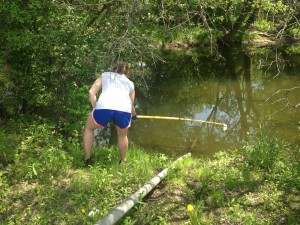Cornell graduate student Laura Strawn and colleagues write in this month’s Applied and Environmental Microbiology (October 2013, volume 79, issue 20):
Identification of management practices associated with preharvest pathogen contamination of produce fields is crucial to the  development of effective Good Agricultural Practices (GAPs).
development of effective Good Agricultural Practices (GAPs).
A cross-sectional study was conducted to (i) determine management practices associated with a Salmonella or Listeria monocytogenes positive field and (ii) quantify the frequency of these pathogens in irrigation and non-irrigation water sources. Over five weeks, 21 produce farms in New York State were visited. Field-level management practices were recorded for 263 fields, and 600 environmental samples (soil, drag swab, and water) were collected and analyzed for Salmonella and L. monocytogenes. Management practices were evaluated for their association with the presence of a pathogen-positive field. Salmonella and L. monocytogenes were detected in 6.1% and 17.5% of fields (n=263), and 11% and 30% of water samples (n=74), respectively. The majority of pathogen-positive water samples were from non-irrigation surface water sources. Multivariate analysis showed that manure application within a year  increased the odds of a Salmonella-positive field (odds ratio [OR] 16.7), while presence of a buffer zone had a protective effect (OR 0.1). Irrigation (within 3 days of sample collection, OR 6.0), reported wildlife observation (within 3 days of sample collection, OR 6.1), and soil cultivation (within 7 days of sample collection, OR 2.9) all increased the likelihood of an L. monocytogenes-positive field.
increased the odds of a Salmonella-positive field (odds ratio [OR] 16.7), while presence of a buffer zone had a protective effect (OR 0.1). Irrigation (within 3 days of sample collection, OR 6.0), reported wildlife observation (within 3 days of sample collection, OR 6.1), and soil cultivation (within 7 days of sample collection, OR 2.9) all increased the likelihood of an L. monocytogenes-positive field.
Our findings provide new data that will assist growers with science-based evaluation of their current GAPs and implementation of preventive controls that reduce the risk of preharvest contamination.
